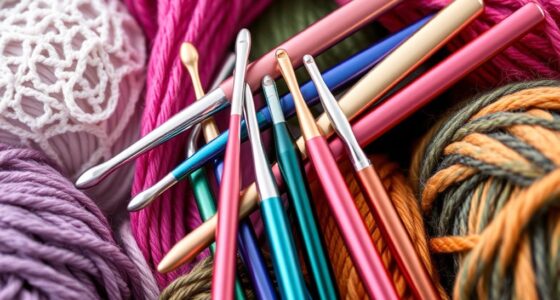To wet felt using roving, you’ll start by laying out fibers in one direction, blending colors and layering for texture. Next, soak the fibers in warm water with a gentle soap, then gently rub and agitate to encourage the fibers’ scales to lock together. The final step, fulling, involves controlled rubbing to compress and stabilize your felt. If you keep exploring, you’ll discover even more tips to perfect your felting technique.
Key Takeaways
- Lay out loose wool roving in layers, aligning fibers for uniform felting and desired textures.
- Soak fibers with warm, soapy water to lubricate fibers and facilitate locking during agitation.
- Rubbing and agitating the fibers cause the wool’s scales to interlock, forming a cohesive felt.
- Fulling involves additional controlled agitation to shrink and strengthen the felt.
- Proper fiber arrangement and consistent rubbing ensure an even, durable, and textured finished product.

Have you ever wondered how to transform wool into a soft, dense fabric? Wet felting is a fascinating process that allows you to do just that, and understanding the role of fiber alignment and color blending can make your projects even more stunning. When you start, you’ll work with loose wool roving, which you lay out carefully on your work surface. To achieve a well-felted fabric, you need to pay close attention to fiber alignment. By arranging the fibers in one direction, you encourage uniformity, which results in a smooth, even surface. Alternately, you can layer fibers at right angles to create more textured or patterned effects. This deliberate alignment influences the final density and strength of your felt. As you add layers, you might blend different colors of wool to introduce subtle shifts or bold contrasts. You can blend colors directly by gently mixing roving or by laying out sections of different colors side by side, allowing them to meld during the felting process. This blending creates rich, nuanced hues that enhance the visual appeal of your finished piece. Additionally, the fiber type you choose can significantly affect the texture and durability of your felt. Once your fibers are laid out with the desired color and alignment, you add soap and water to start the felting process. Use warm water and a gentle, soapy solution to soak the fibers thoroughly. The soap acts as a lubricant, allowing the fibers to glide over each other easily. As you begin to rub and agitate the fibers with your hands, the natural scales on wool fibers start to lock together, creating a dense mat. The key here is consistent, firm rubbing, which encourages fiber entanglement, especially in areas where fibers are aligned. Keep in mind that your careful fiber arrangement will influence how uniformly the fibers felt. If fibers are aligned neatly, the felting will be more even; if they’re layered in different directions, you’ll notice interesting textures and variations. After you’ve achieved the desired thickness and density through rubbing, fulling is the next step. Fulling involves more controlled agitation to compress and shrink the felt, making it sturdy and cohesive. As you full the felt, the fiber alignment becomes even more important because it impacts how the material shrinks and how the colors blend during this stage. The more evenly aligned fibers tend to shrink uniformly, preserving your pattern and color blending efforts. Throughout this process, keep an eye on the overall texture and density. With patience, your wool transforms from loose roving into a beautifully felted fabric where fiber alignment and color blending work together to produce a unique, resilient textile that’s both functional and artistic.
Frequently Asked Questions
Can Wet Felting Be Done With Synthetic Fibers?
Yes, you can wet felt with synthetic fibers, but their felting properties differ from natural fibers. Synthetic fibers often resist felting because they don’t shrink or interlock like wool or merino. To improve felting, you might need to use more soap, agitation, or blend synthetic fibers with natural ones. Keep in mind, achieving a tight, felted surface with purely synthetic fibers can be challenging due to their limited felting properties.
What Safety Precautions Are Necessary During Wet Felting?
You should always prioritize safety during wet felting. Wear protective gear like gloves and goggles to shield your skin and eyes from soap and fibers, and make sure your workspace is well-ventilated to avoid inhaling fumes. Keep your area organized, and handle hot water carefully to prevent burns. By taking these precautions, you create a safe environment where your creativity can flourish effortlessly.
How Long Does It Take for a Wet Felted Piece to Fully Dry?
It usually takes about 24 to 48 hours for your wet felted piece to fully dry, but drying time varies with environmental factors like humidity, airflow, and thickness. You can speed up the process by placing your felt in a well-ventilated area or using a fan. Keep in mind that thicker or denser items might need extra time to dry completely, so check regularly to prevent mold.
Can Wet Felting Be Used for Making Three-Dimensional Sculptures?
Imagine shaping a soft, pliable cloud into a vibrant 3D sculpture—that’s exactly what you can do with wet felting. Yes, wet felting works beautifully for 3D felting and sculpture techniques. You can mold and sculpt fibers into intricate forms, creating everything from animal figures to abstract art. With patience and skill, your felted sculptures will become striking, tactile pieces that showcase the versatility of wet felting in three dimensions.
What Are Common Mistakes to Avoid in Wet Felting?
To avoid common mistakes in wet felting, focus on maintaining even fiber entanglement and preventing uneven felting. You should avoid over-agitating the fibers, which can cause uneven density, and be mindful not to use too much soap, as it can weaken the fibers. Always monitor the felting process closely, ensuring consistent pressure and gentle handling, so your project develops smoothly without unwanted lumps or weak spots.
Conclusion
Now that you’ve explored roving, soap, and fulling, you’re equipped to transform fibers into art with the gentle touch of water and soap. Think of wet felting as weaving a delicate dance between your hands and the fibers, each step bringing your creation to life. With patience and practice, you’ll find yourself immersed in a world where soft fibers become cherished masterpieces—proof that even the simplest materials can craft something extraordinary.









